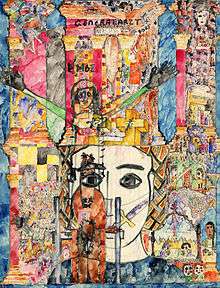Paul Gosch

Paul Gösch (30 August 1885 – 22 August 1940), also Goesch or Göschen, was a German artist, architect, lithographer, and designer of the early twentieth century; he was associated with the main elements of German Expressionism.[1][2][3]
Beginnings
Gösch was born in Schwerin. He suffered from "physical and emotional frailty" throughout his life, but nonetheless maintained "a robust determination to create prolifically and to further the utopian causes of the avant-garde of his time."[4] Born in Schwerin, the son of a lawyer and judge, Gösch grew up in Berlin, where his father held a teaching position at the University of Berlin. Gösch matriculated in the technical college at Berlin-Charlottenburg in 1903 to study architecture. As a student, he reportedly met both Sigmund Freud and Rudolf Steiner. He developed an interest in Anthroposophy, Steiner's version of Theosophy, and later helped construct the Goetheanum in 1913–14. He also suffered his earliest psychiatric hospitalization (1909), but still attained his academic degree. He studied painting in San Remo for six months, and traveled through Italy, France, and Germany, meeting other artists. In 1911 he accepted a post at Kulm (now Chełmno in Poland), and served as city architect there from 1915 to 1917.
Creator
Gösch began a series of "fantasy architecture" plans and sketches in 1914.[5] He suffered a psychotic episode in 1917, and was hospitalized until 1919. After his release he became associated with the November Group and the Arbeitsrat für Kunst and showed works in their exhibitions. He also was a member of the Glass Chain group. Gösch worked with Bruno Taut in Magdeburg on a 1920 restoration project; Taut published artwork and essays by Gösch in his Expressionist journal Frühlicht ("Daybreak" or "First Light").
Artistically, Gösch was a "Specialist in water color"[6] who executed hundreds of images, often of mythological and religious subjects (especially the Virgin Mary). He also wrote and illustrated fairy tales and composed poetry (in the latter, he was strongly influenced by the poet Stefan George).
Mental patient
From 1921 on, Gösch increasingly suffered from psychological difficulties; he became a patient at Göttingen where his brother-in-law was the head of the psychiatric institution. Gösch's murals on the walls of his room still exist there. (At the time he was diagnosed with "dementia praecox," what modern psychiatry would likely diagnose as schizophrenia.) In 1934, under the Nazi regime, Gösch was transferred to the Psychiatric Hospital of Brandenburg at Teupitz, where he was not allowed to paint and forced into manual labor. In 1940, personnel from the SS removed Gösch from Teupitz and murdered him; he was one of the thousands of victims of Action T4, the Nazi euthanasia campaign. The date and place of his execution have been disputed; the most reliable data indicate 22 August 1940, probably at the old prison in Brandenburg.
The combination of artwork and psychiatric problems in Gösch's biography has brought him some attention in the context of the outsider art or "art brut" movement.[7] A number of Gösch's works are included in the collection of psychiatrist and art historian Hans Prinzhorn now maintained at the University of Heidelberg, and were displayed in the Prinzhorn collection exhibit of 1996.[8]
The Canadian Centre for Architecture has more than 200 Gösch drawings in its collection.
See also
References
- ↑ Anonymous, Paul Gösch, 1885–1940: Aquarelle und Zeichnungen, Berlin, Berlinische Galerie, 1976 (exhibition catalogue).
- ↑ Wolfgang Pehnt, Expressionist Architecture, Wetsport, CT, Praeger, 1973.
- ↑ Peter Selz, German Expressionist Painting, Berkeley, University of California Press, 1957.
- ↑ Virginia Haddad, "Paul Gösch," in: Timothy O. Benson et al., Expressionist Utopias: Paradise, Metropolis, Architectural Fantasy, Berkeley, University of California Press, 2001; p. 205.
- ↑ Benson et al., pp. 33, 117, 131.
- ↑ Ulrich Conrads and Hans-Günther Sperlich, The Architecture of Fantasy: Utopian Building and Planning in Modern Times, Westport, CT, Praeger, 1962; p. 159.
- ↑ Eberhard Roters, "Paul Goesch," in: Rough Art, No. 21, Lausanne, Collection of Rough Art, 2001.
- ↑ Peter Popham, "The Broader Picture: The art of schizophrenia," The Independent, 17 November 1996.